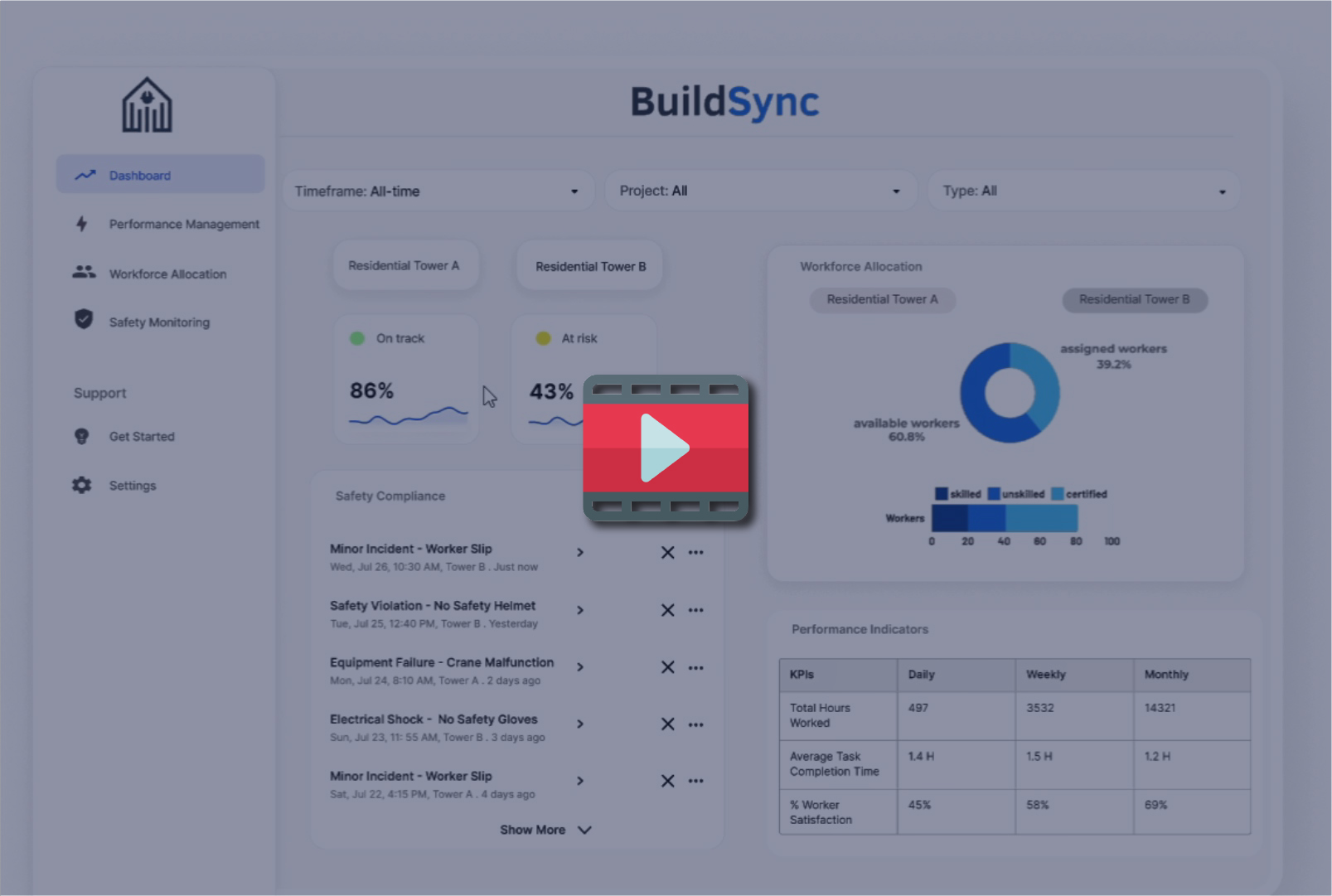Introduction
In an industry where even small inefficiencies can lead to substantial cost overruns, the construction sector faces unique challenges in balancing labor costs, project deadlines, and quality standards. Workforce efficiency plays a pivotal role in managing these factors. By optimizing workforce strategies, construction companies can reduce costs, boost productivity, and improve overall project outcomes.
This post explores essential workforce strategies that construction companies can implement to reduce operational costs, improve productivity, and increase competitiveness.
Understanding the Challenges in Construction Workforce Efficiency
The construction industry has long faced significant challenges that affect workforce efficiency. From fluctuating labor markets and worker shortages to safety compliance and complex project requirements, construction managers must navigate various obstacles to maintain an efficient workforce. Key challenges include:
- Labor Shortages
The construction industry suffers from a growing shortage of skilled labor. Many seasoned professionals are retiring, while fewer young workers are entering the field. This scarcity leads to increased wages, delayed projects, and, ultimately, higher costs for employers. - Safety Regulations
Construction sites must adhere to rigorous safety standards to protect workers. While essential, these regulations require time, resources, and training to maintain compliance, adding to project costs and complexity. - Project Complexity
With each passing year, construction projects grow more complex, often requiring coordination between multiple teams, subcontractors, and suppliers. Managing the workforce effectively across different project phases and locations is crucial for success but challenging without clear strategies. - Rising Material and Labor Costs
Both labor and material costs have risen steadily over recent years. With tight profit margins, construction firms must maximize workforce efficiency to prevent these costs from cutting into profits. - Poor Communication and Delays
A lack of communication can lead to delays, rework, and overall inefficiencies. Keeping everyone updated on project status, tasks, and changes is vital for reducing wasted time and resources.
Workforce Strategies for Boosting Efficiency and Reducing Costs
To overcome these challenges and create a more efficient workforce, construction companies can implement several key strategies:
1. Optimize Workforce Scheduling
Efficient scheduling ensures the right number of workers with the right skills are available for each project phase. By optimizing schedules, companies can prevent bottlenecks, avoid overstaffing, and ensure that work proceeds as planned.
- Use Digital Scheduling Tools: Digital platforms allow managers to visualize workforce needs, track availability, and optimize shifts. These tools are particularly helpful for adjusting schedules in real-time as project needs change.
- Cross-Train Workers: Cross-training employees in multiple skills allows for greater scheduling flexibility. Workers can fill various roles when necessary, ensuring no downtime if someone is unavailable.
2. Implement Real-Time Task Management
Efficient task management ensures workers know exactly what to do, when to do it, and what is expected. Real-time task management allows supervisors to assign tasks, monitor progress, and make adjustments as needed.
- Leverage Mobile Apps for Task Updates: Mobile apps can keep workers informed of their tasks, deadlines, and any changes to the project scope or timeline. This keeps the entire team aligned and helps avoid unnecessary delays.
- Use Visual Tracking Tools: Visual tracking tools, such as Gantt charts or progress bars, offer a clear overview of project status, helping supervisors make informed adjustments and anticipate potential issues.
3. Prioritize Worker Safety and Compliance Training
Safety and compliance training can reduce the risk of accidents and fines, keeping projects on track and within budget. Training workers on industry standards and best practices helps prevent costly incidents.
- Offer Regular Safety Training: Providing safety training regularly ensures that all workers are aware of hazards and protocols. Many companies now use digital training modules that workers can access from mobile devices.
- Integrate Real-Time Safety Alerts: Mobile apps can send real-time alerts regarding safety hazards, providing immediate updates that help prevent incidents and ensure a safer, more productive site.
4. Use Data Analytics for Performance Insights
Analyzing workforce data allows companies to identify trends, track productivity, and make data-driven decisions. Insights derived from data analytics can reveal areas for improvement and highlight successful strategies.
- Track Worker Productivity: Data analytics can help managers monitor individual and team productivity. By tracking metrics such as hours worked, tasks completed, and on-time performance, supervisors can identify high performers and areas that need improvement.
- Predict Staffing Needs: Historical data allows companies to predict workforce needs based on previous project demands, ensuring that they have the right number of workers for each phase without overstaffing.
5. Adopt Modular and Prefabricated Construction
Modular and prefabricated construction methods can reduce onsite labor needs, allowing workers to assemble pre-made components instead of building from scratch. This can reduce project timelines and improve efficiency.
- Enhance Precision and Reduce Waste: Prefabrication allows for precision manufacturing in controlled environments, which minimizes material waste and speeds up construction.
- Reduce On-Site Work Time: With modular construction, larger sections of a project are completed offsite, reducing the labor needed onsite and improving safety as fewer workers are required in potentially hazardous environments.
6. Streamline Recruitment and Onboarding
Recruiting and onboarding can be time-consuming processes. Streamlining these steps helps companies get workers onsite faster and reduce hiring-related costs.
- Utilize Digital Recruitment Tools: Digital platforms allow for faster candidate screening and communication, enabling managers to fill roles more efficiently. Some systems also allow companies to build a pool of potential workers they can call upon as needed.
- Digital Onboarding Resources: Using online onboarding materials, such as training videos and safety tutorials, helps new hires get up to speed quickly, ensuring they’re ready to work without delay.
7. Promote Employee Retention Through Engagement and Incentives
High turnover can lead to added costs from recruiting, onboarding, and training new workers. Employee engagement programs, performance incentives, and recognition can improve retention, allowing companies to retain skilled labor and reduce workforce-related costs.
- Offer Incentives for High Performance: Incentivizing top performers through bonuses, recognition, and career advancement opportunities keeps workers motivated.
- Provide Career Development Opportunities: Offering workers opportunities to advance or develop new skills encourages them to stay with the company longer, building a loyal and experienced workforce.
Leveraging Technology for Better Workforce Efficiency
Technology is a key enabler of all the strategies listed above. By adopting digital tools and software, construction companies can create a more connected, informed, and efficient workforce.
- Mobile Apps for On-the-Go Communication: Mobile apps allow workers to receive updates, check schedules, and communicate with supervisors instantly, ensuring that everyone is on the same page and eliminating delays caused by miscommunication.
- Cloud-Based Platforms for Remote Collaboration: Cloud-based platforms enable teams to work together from different locations, which is particularly useful for large-scale projects spread across multiple sites.
- AI-Driven Workforce Management: AI can optimize workforce scheduling, predict project timelines, and even help with risk assessment by analyzing patterns in workforce data.
Implementing Workforce Strategies for Long-Term Success
While these workforce strategies can yield immediate benefits, their true value is realized when applied consistently over the long term. Construction companies should consider the following steps when implementing workforce strategies:
- Start with a Pilot Program: Implement new tools or processes on a single project or team to evaluate effectiveness. Gather feedback from workers and managers to identify areas for improvement before expanding the program.
- Invest in Ongoing Training: As technology and workforce strategies evolve, companies should provide continuous training to keep their teams up to date with the latest tools, skills, and industry best practices.
- Set Measurable Goals: Define specific metrics for workforce productivity, such as task completion times, safety compliance rates, or overall project timelines. Tracking these metrics helps companies measure success and make data-driven adjustments.
- Foster a Culture of Efficiency: Encourage workers to embrace productivity-boosting strategies by creating a company culture that values efficiency, collaboration, and continuous improvement.
Conclusion
Construction companies face a unique set of challenges in creating an efficient, productive workforce, but with the right strategies and tools, they can overcome these obstacles. By optimizing scheduling, implementing real-time task management, investing in safety training, leveraging data analytics, and adopting digital tools, companies can increase workforce efficiency, reduce costs, and improve project outcomes.
In an industry known for tight margins and high stakes, workforce efficiency isn’t just a goal—it’s a necessity for long-term success. As the construction landscape continues to evolve, companies that prioritize workforce management will be better equipped to meet the demands of the future, positioning themselves as leaders in a highly competitive field.



